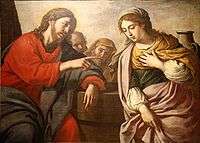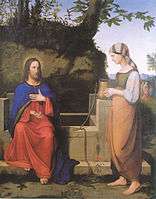Samaritan woman at the well


The Samaritan woman at the well is a figure from the Gospel of John, in John 4:4–26. In the traditions of the Eastern Orthodox Church, she is considered to be a saint, named Photine or Photini/Photina (the luminous one, from φως, "light").
Biblical account
According to John 4:4-26:
But he had to go through Samaria. So he came to a Samaritan city called Sychar, near the plot of ground that Jacob had given to his son Joseph. Jacob’s well was there, and Jesus, tired out by his journey, was sitting by the well. It was about noon.
A Samaritan woman came to draw water, and Jesus said to her, ‘Give me a drink’. (His disciples had gone to the city to buy food.) The Samaritan woman said to him, ‘How is it that you, a Jew, ask a drink of me, a woman of Samaria?’ (Jews do not share things in common with Samaritans.) Jesus answered her, ‘If you knew the gift of God, and who it is that is saying to you, “Give me a drink”, you would have asked him, and he would have given you living water.’ The woman said to him, ‘Sir, you have no bucket, and the well is deep. Where do you get that living water? Are you greater than our ancestor Jacob, who gave us the well, and with his sons and his flocks drank from it?’ Jesus said to her, ‘Everyone who drinks of this water will be thirsty again, but those who drink of the water that I will give them will never be thirsty. The water that I will give will become in them a spring of water gushing up to eternal life.’ The woman said to him, ‘Sir, give me this water, so that I may never be thirsty or have to keep coming here to draw water.’
Jesus said to her, ‘Go, call your husband, and come back.’ The woman answered him, ‘I have no husband.’ Jesus said to her, ‘You are right in saying, “I have no husband”; for you have had five husbands, and the one you have now is not your husband. What you have said is true!’ The woman said to him, ‘Sir, I see that you are a prophet. Our ancestors worshipped on this mountain, but you say that the place where people must worship is in Jerusalem.’ Jesus said to her, ‘Woman, believe me, the hour is coming when you will worship the Father neither on this mountain nor in Jerusalem. You worship what you do not know; we worship what we know, for salvation is from the Jews. But the hour is coming, and is now here, when the true worshippers will worship the Father in spirit and truth, for the Father seeks such as these to worship him. God is spirit, and those who worship him must worship in spirit and truth.’ The woman said to him, ‘I know that Messiah is coming’ (who is called Christ). ‘When he comes, he will proclaim all things to us.’ Jesus said to her, ‘I am he, the one who is speaking to you.’[1]
This episode takes place before the return of Jesus to Galilee.[2] Some Jews regarded the Samaritans as foreigners and their attitude was often hostile, although they shared most beliefs. while many other Jews accepted Samaritans as either fellow Jews or as Samaritan Israelites.[3] The two communities seem to have drifted apart in the post-exilic period.[4] Both communities share the Pentateuch, although crucially the Samaritan Pentateuch locates the holy mountain at Mount Gerizim rather than at Mount Zion, as this incident acknowledges at John 4:20.
The Gospel of John, like the Gospel of Luke, is favourable to the Samaritans, unlike the Matthew Gospel which quotes Jesus as telling his followers not to enter any of the cities of the Samaritans.[5] Scholars differ as to whether the Samaritan references in the New Testament are historical. One view is that the historical Jesus had no contact with Samaritans; another is that the accounts go back to Jesus himself. Note that in Acts 1: 8, Jesus promises the apostles that they will be witnesses to the Samaritans.[6]
Interpretations
Scholars have noted that this story appears to be modelled on a standard betrothal scene from Hebrew scriptures, particularly that of Jacob in Genesis 29.[7] This convention, which would have been familiar to Jewish readers, is subverted by presenting Jesus as the bridegroom of the Jewish people, in a scene which follows on from a scene in which John the Baptist compares his relationship to Jesus with that of the friend of a bridegroom.[2]
This Gospel episode is referred to as "a paradigm for our engagement with truth", in the Roman Curia book A Christian reflection on the New Age, as the dialogue says: "You worship what you do not know; we worship what we know" and offers an example of "Jesus Christ the bearer of the water of life".[8] The passages that comprise John 4:10–26 are sometimes referred to as the Water of Life Discourse, which forms a complement to the Bread of Life Discourse.[9]
In Eastern Orthodox Church tradition, her name at the time of the meeting with Jesus is unknown, though she later received the name Photini in baptism. She is celebrated as a saint of renown. As further recounted in John 4:28-30 and John 4:39-42, she was quick to spread the news of her meeting with Jesus, and through this many came to believe in him. Her continuing witness is said to have brought so many to the Christian faith that she is described as "equal to the apostles". Eventually, having drawn the attention of Emperor Nero, she was brought before him to answer for her faith, suffered many tortures, and died a martyr after being thrown down a dry well. She is remembered on the Sunday four weeks after Pascha (Easter), which is known as "the Sunday of the Samaritan Woman".
In Oaxaca, Oaxaca, Mexico, a celebration of the Samaritan woman takes place on the fourth Friday of Lent. Churches, schools, and businesses give away fruit drinks to passers by.[10]
Cultural references
In visual art
- Jesus and the Samaritan Woman at the Well
-

Christ and the Samaritan Woman, by Duccio di Buoninsegna
-

Jesus and the Samaritan Woman at the Well, by Giacomo Franceschini
-

Christ and the Samaritan Woman, by Stefano Erardi
-

Christ and the Samaritan Woman, by Jan Joest van Kalkar
-

Jesus and the Samaritan Woman at the Well, by Guercino
-

Christ and the Samaritan Woman, by Josef von Hempel
-
.jpg)
Christ and the Samaritan Woman, by Lucas Cranach the Elder
-

Woman at the Well by Carl Heinrich Bloch
In music
- "Jesus Met the Woman at the Well", a gospel song dating from 1949 or before (earliest known recording, by The Fairfield Four)
- "Lift Him Up That's All", a gospel song dating from 1927 or before (earliest known recording, by Washington Phillips)
- The Woman of Samaria, a sacred cantata of 1867 by the English classical composer William Sterndale Bennett
See also
-
 Media related to Samaritan woman at the well at Wikimedia Commons
Media related to Samaritan woman at the well at Wikimedia Commons - Jesus' interactions with women
- List of names for the biblical nameless
- Parable of the Good Samaritan
- Domnina (daughter of Nero)
Notes
- ↑ John 4:4-26
- 1 2 Lincoln, Andrew T. (2005). The Gospel According to Saint John. Peabody, Mass.: Hendrickson Publishers. pp. 170–1. ISBN 1-56563-401-2. OCLC 61129929. Retrieved 3 June 2013.
- ↑ V. J. Samkutty, The Samaritan Mission in Acts (Library of New Testament Studies 328; A&C Black, 2006), 81; online: https://books.google.com/books?id=g_VSm2aOm4UC&pg=PA81&dq=%22Many+of+the+early+tannaim%22&hl=en&sa=X&ved=0CB0Q6AEwAGoVChMIw_qXmOTNyAIVRHo-Ch3fHwCO#v=onepage&q=%22Many%20of%20the%20early%20tannaim%22&f=false; accessed 19 Oct 2015. See also Alan David Crown, Lucy Davey, and Guy Dominique Sixdenier, eds., Essays in Honour of G.D. Sexdenier: New Samaritan Studies of the Société D'études Samaritaines (Studies in Judaica 5; Sydney: Mandelbaum / University of Sydney, 1995), 134.
- ↑ Ferguson, Everett. Backgrounds of Early Christianity. Wm. B. Eerdmans Publishing. p. 534.
- ↑ V. J. Samkutty, The Samaritan Mission in Acts (Continuum, 2006) page 85.
- ↑ V. J. Samkutty, The Samaritan Mission in Acts (Continuum, 2006) page 100-101.
- ↑ Kevin Quast, Reading the Gospel of John: An Introduction (Paulist Press, 1991)page 29.
- ↑ Pontifical Council for Culture; Pontifical Council for Interreligious Dialogue (2 March 2003). Jesus Christ the Bearer of the Water of Life: A Christian reflection on the "New Age". Vatican City: Internet Office of the Holy See.
- ↑ Barrett, C. K. (1978). The Gospel According to St. John: An Introduction With Commentary and Notes on the Greek Text (2nd ed.). Philadelphia: The Westminster Press. p. 12. ISBN 0-664-22180-7. Retrieved 3 June 2013.
- ↑ "La Samaritana 2011 en Oaxaca" (in Spanish). Vive Oaxaca. Retrieved 3 June 2013.